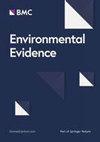Herbivore diversity effects on Arctic tundra ecosystems: a systematic review
IF 5.2
4区 环境科学与生态学
Q2 ENVIRONMENTAL SCIENCES
引用次数: 0
Abstract
Northern ecosystems are strongly influenced by herbivores that differ in their impacts on the ecosystem. Yet the role of herbivore diversity in shaping the structure and functioning of tundra ecosystems has been overlooked. With climate and land-use changes causing rapid shifts in Arctic species assemblages, a better understanding of the consequences of herbivore diversity changes for tundra ecosystem functioning is urgently needed. This systematic review synthesizes available evidence on the effects of herbivore diversity on different processes, functions, and properties of tundra ecosystems. Following a published protocol, our systematic review combined primary field studies retrieved from bibliographic databases, search engines and specialist websites that compared tundra ecosystem responses to different levels of vertebrate and invertebrate herbivore diversity. We used the number of functional groups of herbivores (i.e., functional group richness) as a measure of the diversity of the herbivore assemblage. We screened titles, abstracts, and full texts of studies using pre-defined eligibility criteria. We critically appraised the validity of the studies, tested the influence of different moderators, and conducted sensitivity analyses. Quantitative synthesis (i.e., calculation of effect sizes) was performed for ecosystem responses reported by at least five articles and meta-regressions including the effects of potential modifiers for those reported by at least 10 articles. The literature searches retrieved 5944 articles. After screening titles, abstracts, and full texts, 201 articles including 3713 studies (i.e., individual comparisons) were deemed relevant for the systematic review, with 2844 of these studies included in quantitative syntheses. The available evidence base on the effects of herbivore diversity on tundra ecosystems is concentrated around well-established research locations and focuses mainly on the impacts of vertebrate herbivores on vegetation. Overall, greater herbivore diversity led to increased abundance of feeding marks by herbivores and soil temperature, and to reduced total abundance of plants, graminoids, forbs, and litter, plant leaf size, plant height, and moss depth, but the effects of herbivore diversity were difficult to tease apart from those of excluding vertebrate herbivores. The effects of different functional groups of herbivores on graminoid and lichen abundance compensated each other, leading to no net effects when herbivore effects were combined. In turn, smaller herbivores and large-bodied herbivores only reduced plant height when occurring together but not when occurring separately. Greater herbivore diversity increased plant diversity in graminoid tundra but not in other habitat types. This systematic review underscores the importance of herbivore diversity in shaping the structure and function of Arctic ecosystems, with different functional groups of herbivores exerting additive or compensatory effects that can be modulated by environmental conditions. Still, many challenges remain to fully understand the complex impacts of herbivore diversity on tundra ecosystems. Future studies should explicitly address the role of herbivore diversity beyond presence-absence, targeting a broader range of ecosystem responses and explicitly including invertebrate herbivores. A better understanding of the role of herbivore diversity will enhance our ability to predict whether and where shifts in herbivore assemblages might mitigate or further amplify the impacts of environmental change on Arctic ecosystems.食草动物多样性对北极苔原生态系统的影响:系统综述
北方生态系统受到食草动物的强烈影响,这些食草动物对生态系统的影响各不相同。然而,食草动物多样性在塑造苔原生态系统结构和功能方面的作用却一直被忽视。随着气候和土地利用的变化导致北极物种组合的快速变化,迫切需要更好地了解食草动物多样性变化对苔原生态系统功能的影响。本系统综述综合了食草动物多样性对苔原生态系统不同过程、功能和特性的影响的现有证据。根据已发布的协议,我们的系统综述综合了从文献数据库、搜索引擎和专业网站检索到的主要实地研究,这些研究比较了冻原生态系统对不同程度的脊椎动物和无脊椎动物食草动物多样性的反应。我们用食草动物功能群的数量(即功能群丰富度)来衡量食草动物组合的多样性。我们按照预先确定的资格标准筛选了研究的标题、摘要和全文。我们对研究的有效性进行了严格评估,测试了不同调节因子的影响,并进行了敏感性分析。对至少有五篇文章报道的生态系统反应进行了定量综合(即计算效应大小),对至少有十篇文章报道的生态系统反应进行了元回归(包括潜在调节因子的影响)。文献检索共检索到 5944 篇文章。在对标题、摘要和全文进行筛选后,201 篇文章(包括 3713 项研究(即单项比较))被认为与系统综述相关,其中 2844 项研究被纳入定量综述。关于食草动物多样性对苔原生态系统影响的现有证据基础主要集中在成熟的研究地点,并主要集中在脊椎动物食草动物对植被的影响上。总体而言,草食动物多样性增加会导致草食动物取食痕迹和土壤温度增加,植物、禾本科植物、草本植物和枯落物的总丰度、植物叶片大小、植物高度和苔藓深度降低,但草食动物多样性的影响很难与排除脊椎动物草食动物的影响区分开来。不同功能群的食草动物对禾本科植物和地衣丰度的影响是相互补偿的,因此当综合考虑食草动物的影响时,没有净影响。反过来,小型食草动物和大型食草动物同时出现时只会降低植物高度,而单独出现时则不会。食草动物多样性的增加提高了禾本科苔原植物的多样性,但对其他生境类型没有影响。这篇系统综述强调了食草动物多样性在塑造北极生态系统结构和功能方面的重要性,不同功能群的食草动物会产生叠加效应或补偿效应,这些效应可由环境条件调节。尽管如此,要充分了解食草动物多样性对苔原生态系统的复杂影响仍面临许多挑战。未来的研究应明确探讨食草动物多样性的作用,而不仅仅是存在与不存在之间的关系,以更广泛的生态系统响应为目标,并明确包括无脊椎食草动物。更好地了解食草动物多样性的作用将提高我们预测食草动物群落的变化是否会减轻或进一步扩大环境变化对北极生态系统的影响的能力。
本文章由计算机程序翻译,如有差异,请以英文原文为准。
求助全文
约1分钟内获得全文
求助全文
来源期刊

Environmental Evidence
Environmental Science-Management, Monitoring, Policy and Law
CiteScore
6.10
自引率
18.20%
发文量
36
审稿时长
17 weeks
期刊介绍:
Environmental Evidence is the journal of the Collaboration for Environmental Evidence (CEE). The Journal facilitates rapid publication of evidence syntheses, in the form of Systematic Reviews and Maps conducted to CEE Guidelines and Standards. We focus on the effectiveness of environmental management interventions and the impact of human activities on the environment. Our scope covers all forms of environmental management and human impacts and therefore spans the natural and social sciences. Subjects include water security, agriculture, food security, forestry, fisheries, natural resource management, biodiversity conservation, climate change, ecosystem services, pollution, invasive species, environment and human wellbeing, sustainable energy use, soil management, environmental legislation, environmental education.
 求助内容:
求助内容: 应助结果提醒方式:
应助结果提醒方式:


